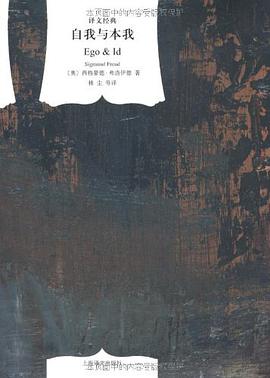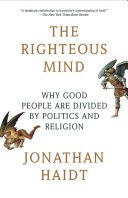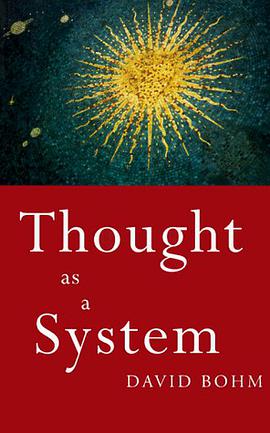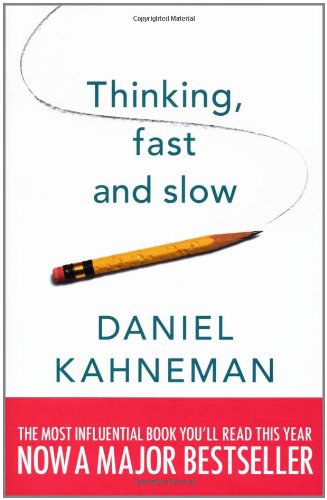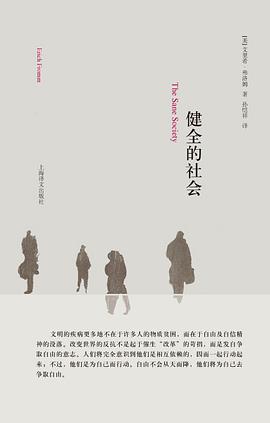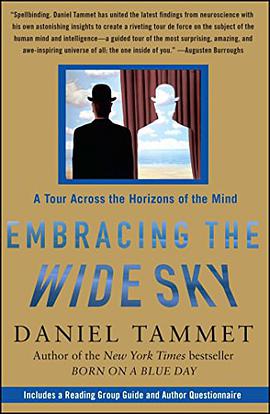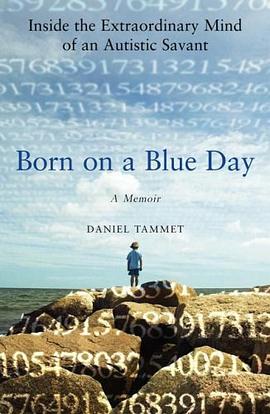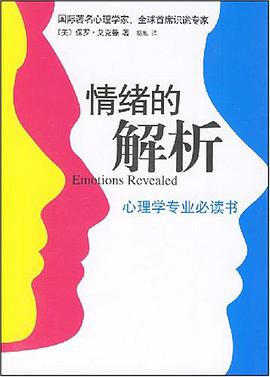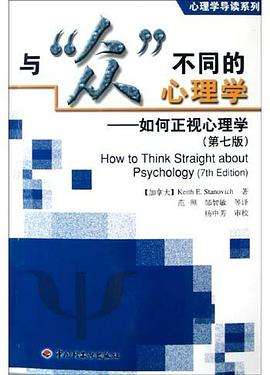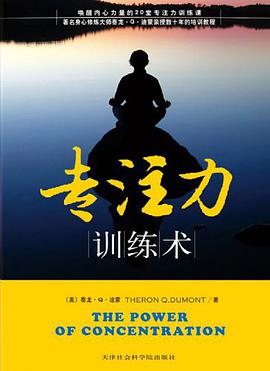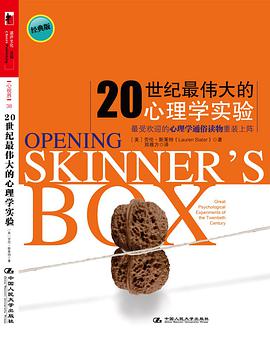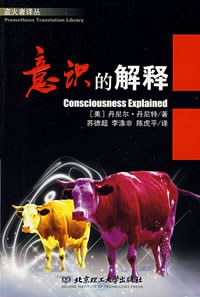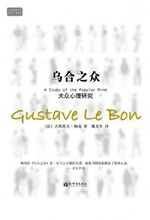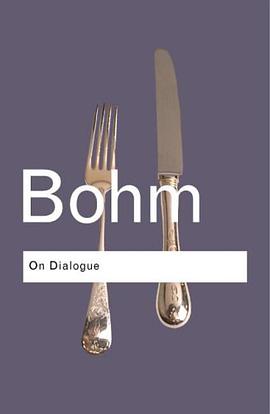心理
The Righteous Mind 豆瓣
作者:
Jonathan Haidt
Pantheon
2012
- 3
Why can’t our political leaders work together as threats loom and problems mount? Why do people so readily assume the worst about the motives of their fellow citizens? In The Righteous Mind, social psychologist Jonathan Haidt explores the origins of our divisions and points the way forward to mutual understanding.
His starting point is moral intuition—the nearly instantaneous perceptions we all have about other people and the things they do. These intuitions feel like self-evident truths, making us righteously certain that those who see things differently are wrong. Haidt shows us how these intuitions differ across cultures, including the cultures of the political left and right. He blends his own research findings with those of anthropologists, historians, and other psychologists to draw a map of the moral domain, and he explains why conservatives can navigate that map more skillfully than can liberals. He then examines the origins of morality, overturning the view that evolution made us fundamentally selfish creatures. But rather than arguing that we are innately altruistic, he makes a more subtle claim—that we are fundamentally groupish. It is our groupishness, he explains, that leads to our greatest joys, our religious divisions, and our political affiliations. In a stunning final chapter on ideology and civility, Haidt shows what each side is right about, and why we need the insights of liberals, conservatives, and libertarians to flourish as a nation.
His starting point is moral intuition—the nearly instantaneous perceptions we all have about other people and the things they do. These intuitions feel like self-evident truths, making us righteously certain that those who see things differently are wrong. Haidt shows us how these intuitions differ across cultures, including the cultures of the political left and right. He blends his own research findings with those of anthropologists, historians, and other psychologists to draw a map of the moral domain, and he explains why conservatives can navigate that map more skillfully than can liberals. He then examines the origins of morality, overturning the view that evolution made us fundamentally selfish creatures. But rather than arguing that we are innately altruistic, he makes a more subtle claim—that we are fundamentally groupish. It is our groupishness, he explains, that leads to our greatest joys, our religious divisions, and our political affiliations. In a stunning final chapter on ideology and civility, Haidt shows what each side is right about, and why we need the insights of liberals, conservatives, and libertarians to flourish as a nation.
Thought as a System 豆瓣
作者:
David Bohm
Routledge
1994
This study concerns the role of thought and knowledge. The author rejects the notion that our thinking processes neutrally report on what is "out there" in an objective world. He explores the manner in which thought actively participates in forming our perceptions, our sense of meaning and our daily actions. He suggests that collective thought and knowledge have become so automated that we are in large part controlled by them, with a subsequent loss of authenticity, freedom and order.
Thinking Fast and Slow 豆瓣
作者:
Daniel Kahneman
LANE ALLEN
2011
- 11
Daniel Kahneman, recipient of the Nobel Prize in Economic Sciences for his seminal work in psychology challenging the rational model of judgment and decision making, is one of the world's most important thinkers. His ideas have had a profound impact on many fields-including business, medicine, and politics-but until now, he has never brought together his many years of research in one book. In "Thinking, Fast and Slow", Kahneman takes us on a groundbreaking tour of the mind and explains the two systems that drive the way we think and make choices. One system is fast, intuitive, and emotional; the other is slower, more deliberative, and more logical. Kahneman exposes the extraordinary capabilities-and also the faults and biases-of fast thinking, and reveals the pervasive influence of intuitive impressions on our thoughts and behaviour.
The importance of properly framing risks, the effects of cognitive biases on how we view others, the dangers of prediction, the right ways to develop skills, the pros and cons of fear and optimism, the difference between our experience and memory of events, the real components of happiness-each of these can be understood only by knowing how the two systems work together to shape our judgments and decisions. Drawing on a lifetime's experimental experience, Kahneman reveals where we can and cannot trust our intuitions and how we can tap into the benefits of slow thinking. He offers practical and enlightening insights into how choices are made in both our professional and our personal lives-and how we can use different techniques to guard against the mental glitches that often get us into trouble. "Thinking, Fast and Slow" will transform the way you take decisions and experience the world.
The importance of properly framing risks, the effects of cognitive biases on how we view others, the dangers of prediction, the right ways to develop skills, the pros and cons of fear and optimism, the difference between our experience and memory of events, the real components of happiness-each of these can be understood only by knowing how the two systems work together to shape our judgments and decisions. Drawing on a lifetime's experimental experience, Kahneman reveals where we can and cannot trust our intuitions and how we can tap into the benefits of slow thinking. He offers practical and enlightening insights into how choices are made in both our professional and our personal lives-and how we can use different techniques to guard against the mental glitches that often get us into trouble. "Thinking, Fast and Slow" will transform the way you take decisions and experience the world.
健全的社会 豆瓣
9.5 (12 个评分)
作者:
[美]艾里希·弗洛姆
译者:
孙恺祥
上海译文出版社
2011
- 9
《健全的社会》是社会心理学领域的经典之作,是对现代社会中人的精神状况的一次有力的探索。
精神健康的问题是否只涉及某些“不适应”社会的个体?社会作为整体是否会患上精神病?对此,弗洛姆给出了肯定的回答。现代社会使人们与自己创造的事物、自己建立的组织、其他人,甚至自己疏离开来。现代资本主义造就了“可支配的人格”。对这种趋势放任自流的结果将是为异化力量所支配的精神失常的社会。在深入分析了资本主义和共产主义的各种社会组织方案后,弗洛姆提出了第三种方案:在理想的社会中,个人不再是达成其他人的目的的手段,个人的幸福是社会的核心关注点,社会的经济增长不应凌驾于个人的发展之上;在精神健全的社会中,个人应当富有创造力和责任感。
作为人本主义精神分析学派的代表人物,弗洛姆对于人和社会的关系的看法与传统的弗洛伊德派的观点有根本的区别。后者将性欲视做人的感情和欲望的基本动力。对此,弗洛姆明确提出:人的基本感情并不植根于他的本能需要,而是产生自人类生存的特殊环境。从中我们可以窥见马克思的人本主义学说的影响。
精神健康的问题是否只涉及某些“不适应”社会的个体?社会作为整体是否会患上精神病?对此,弗洛姆给出了肯定的回答。现代社会使人们与自己创造的事物、自己建立的组织、其他人,甚至自己疏离开来。现代资本主义造就了“可支配的人格”。对这种趋势放任自流的结果将是为异化力量所支配的精神失常的社会。在深入分析了资本主义和共产主义的各种社会组织方案后,弗洛姆提出了第三种方案:在理想的社会中,个人不再是达成其他人的目的的手段,个人的幸福是社会的核心关注点,社会的经济增长不应凌驾于个人的发展之上;在精神健全的社会中,个人应当富有创造力和责任感。
作为人本主义精神分析学派的代表人物,弗洛姆对于人和社会的关系的看法与传统的弗洛伊德派的观点有根本的区别。后者将性欲视做人的感情和欲望的基本动力。对此,弗洛姆明确提出:人的基本感情并不植根于他的本能需要,而是产生自人类生存的特殊环境。从中我们可以窥见马克思的人本主义学说的影响。
爱的艺术 豆瓣 Goodreads
The Art of Loving
8.6 (51 个评分)
作者:
[美] 弗洛姆
译者:
李健鸣
上海译文出版社
2011
- 7
《爱的艺术》是德裔美籍心理学家和哲学家、法兰克福学派重要成员艾里希-弗洛姆最著名的作品,自1956年出版至今已被翻译成32种文字,在全世界畅销不衰,被誉为当代爱的艺术理论专著最著名的作品。
在这本书中,弗洛姆认为,爱情不是一种与人的成熟程度无关,只需要投入身心的感情。如果不努力发展自己的全部人格并以此达到一种创造倾向性,那么每种爱的试图都会失败,如果没有爱他人的能力,如果不能真正谦恭地、勇敢地、真诚地和有纪律地爱他人,那么人们在自己的爱情生活中也永远得不到满足。
弗洛姆进而提出,爱是一门艺术,要求想要掌握这门艺术的人有这方面的知识并付出努力。在这里,爱不仅仅是狭隘的男女爱情,也并非通过磨练增进技巧即可获得。爱是人格整体的展现,要发展爱的能力,就需要努力发展自己的人格,并朝着有益的目标迈进。
此版特别收录弗洛姆学术助手纪念文章《弗洛姆生命中的爱》。
在这本书中,弗洛姆认为,爱情不是一种与人的成熟程度无关,只需要投入身心的感情。如果不努力发展自己的全部人格并以此达到一种创造倾向性,那么每种爱的试图都会失败,如果没有爱他人的能力,如果不能真正谦恭地、勇敢地、真诚地和有纪律地爱他人,那么人们在自己的爱情生活中也永远得不到满足。
弗洛姆进而提出,爱是一门艺术,要求想要掌握这门艺术的人有这方面的知识并付出努力。在这里,爱不仅仅是狭隘的男女爱情,也并非通过磨练增进技巧即可获得。爱是人格整体的展现,要发展爱的能力,就需要努力发展自己的人格,并朝着有益的目标迈进。
此版特别收录弗洛姆学术助手纪念文章《弗洛姆生命中的爱》。
Embracing the Wide Sky 豆瓣
作者:
Daniel Tammet
Atria Books
2009
Owner of "the most remarkable mind on the planet," (according to Entertainment Weekly ) Daniel Tammet captivated readers and won worldwide critical acclaim with the 2007 New York Times bestselling memoir, Born On A Blue Day , and its vivid depiction of a life with autistic savant syndrome. In his fascinating new book, he writes with characteristic clarity and personal awareness as he sheds light on the mysteries of savants' incredible mental abilities, and our own. Tammet explains that the differences between savant and non-savant minds have been exaggerated; his astonishing capacities in memory, math and language are neither due to a cerebral supercomputer nor any genetic quirk, but are rather the results of a highly rich and complex associative form of thinking and imagination. Autistic thought, he argues, is an extreme variation of a kind that we all do, from daydreaming to the use of puns and metaphors. Embracing the Wide Sky combines meticulous scientific research with Tammet's detailed descriptions of how his mind works to demonstrate the immense potential within us all. He explains how our natural intuitions can help us to learn a foreign language, why his memories are like symphonies, and what numbers and giraffes have in common. We also discover why there is more to intelligence than IQ, how optical illusions fool our brains, and why too much information can make you dumb. Many readers will be particularly intrigued by Tammet's original ideas concerning the genesis of genius and exceptional creativity. He illustrates his arguments with examples as diverse as the private languages of twins, the compositions of poets with autism, and the breakthroughs, and breakdowns, of some of history's greatest minds. Embracing the Wide Sky is a unique and brilliantly imaginative portrait of how we think, learn, remember and create, brimming with personal insights and anecdotes, and explanations of the most up-to-date, mind-bending discoveries from fields ranging from neuroscience to psychology and linguistics. This is a profound and provocative book that will transform our understanding and respect for every kind of mind.
Born on a Blue Day 豆瓣
作者:
Daniel Tammet
Hodder & Stoughton
2006
- 7
Daniel sees numbers as shapes, colours and textures and can perform extraordinary maths in his head. He has Savant Syndrome, an extremely rare form of Asperger's that gives him almost unimaginable mental powers. This book explores what it's like to be special and in so doing gives us an insight into what makes us all human - our minds.
情绪的解析 豆瓣 Goodreads
8.6 (10 个评分)
作者:
[美] 保罗·艾克曼
译者:
杨旭
南海出版公司
2008
- 1
你兢兢业业却总不能升职,你是忍气吞声还是据理力争或者干脆炒老板鱿鱼?一时冲动和爱人吵架,你能不能先冷静下来,还是各不相让以致感情破裂?你苦口婆心,可孩子就是不听话,你能否保持心平气和,还是暴跳如雷,甚至拳脚相加?有什么样的情绪反应,就有什么样的生活!正确调节自己的情绪,并理解他人的情绪,可以让生活顺风顺水;错误表达自己的情绪,忽视甚至误解他人的情绪,就可能招致不可估量的损失。
保罗·艾克曼是享誉全球的著名心理学家、全球首席识谎专家,专精于非语言沟通。美国联邦调查局、中央情报局、警方、反恐小组等政府机构,以及皮克斯动画公司,常常请他当表情顾问。40年来,他系统研究新几内亚土著、精神分裂症患者、间谍、连续杀人犯和职业杀手的面容,《情绪的解析》就是他集大成的突破性研究成果。本书科学地解析了产生情绪时体内的生理变化、外在的肢体语言、声音、面部表情等方面,并提供小测试和练习,考察你对情绪的了解,帮你认清自己和他人最细微的情绪表现,提高你对情绪发生的敏感度。
我们的生活中不能没有情绪,我们要在情绪的世界里生活得更好!
保罗·艾克曼是享誉全球的著名心理学家、全球首席识谎专家,专精于非语言沟通。美国联邦调查局、中央情报局、警方、反恐小组等政府机构,以及皮克斯动画公司,常常请他当表情顾问。40年来,他系统研究新几内亚土著、精神分裂症患者、间谍、连续杀人犯和职业杀手的面容,《情绪的解析》就是他集大成的突破性研究成果。本书科学地解析了产生情绪时体内的生理变化、外在的肢体语言、声音、面部表情等方面,并提供小测试和练习,考察你对情绪的了解,帮你认清自己和他人最细微的情绪表现,提高你对情绪发生的敏感度。
我们的生活中不能没有情绪,我们要在情绪的世界里生活得更好!
与“众”不同的心理学 豆瓣 Goodreads 谷歌图书
How To Think Straight About Psychology
8.5 (13 个评分)
作者:
Keith E.Stanovich
译者:
范照
中国轻工业出版社
2005
- 2
本书介绍了心理学研究的本质、内容、科学方法和社会意义,它以深入浅出、充满睿智的论述去纠正人们对心理学的误解,帮助读者了解心理学的真相。可以说它是一本引导“消费者”认识心理学“文化产品”的指南,故定名为《与“众”不同的心理学》。
本书对揭开人们对心理学之误解的面纱做了很大的贡献,让读者看清心理学的真面目。强力推荐这本书给所有想知道心理学是怎么样一回事以及心理学知识是如何累积起来的读者。它指出心理学虽是一门新兴的科学,但是却拥有一个非常古老的传统,因此人们对它的误解也很深,以为对心理学研究所累积的知识,可以不用现代“科学”的标准来衡量及评价。
本书则告诉我们,判定心理学知识的好坏,是和其他的科学一样,一定要用“科学”的标准。书中用了许多精彩的例子说明这些标准是什么,以及要如何用之来分辨真正的科学心理学知识与迷域大众的伪科学心理学常识。
本书对揭开人们对心理学之误解的面纱做了很大的贡献,让读者看清心理学的真面目。强力推荐这本书给所有想知道心理学是怎么样一回事以及心理学知识是如何累积起来的读者。它指出心理学虽是一门新兴的科学,但是却拥有一个非常古老的传统,因此人们对它的误解也很深,以为对心理学研究所累积的知识,可以不用现代“科学”的标准来衡量及评价。
本书则告诉我们,判定心理学知识的好坏,是和其他的科学一样,一定要用“科学”的标准。书中用了许多精彩的例子说明这些标准是什么,以及要如何用之来分辨真正的科学心理学知识与迷域大众的伪科学心理学常识。
专注力训练术 豆瓣
作者:
泰龙·Q·迪蒙
译者:
洪友
天津社会科学院出版社
2012
- 3
《专注力训练术》内容简介:专注力,决定一个人成败的神奇心灵力量,与《气场研习术》配套的专注力训练教程,唤醒和利用你强大内心力量的20堂心灵课。你是否停下来想一想,专注在我们的个人生活中起着多么重要的作用!任何人想要成功,必须具备这种行事专注的品质。如果每天能坚持进行几次专注力训练,你就会发现自己很快便能展示出这种能力。
作为《专注力训练术》读者,你将发现这20堂课程非常实用,其中的练习都是学员们亲身测试过的,这些训练为你提供了一个自我帮助与自我改善的途径。由于我们并非天生具备这些能力,所以《专注力训练术》侧重教你如何通过训练获得这种力量。通过这些课程,作者试图唤醒你内心深处的那种神秘力量。
要想最大限度地从本书中受益,你必须读完最后一页,掩卷沉思,悉心体会。这也是培养你专注习惯的重要一步。
作为《专注力训练术》读者,你将发现这20堂课程非常实用,其中的练习都是学员们亲身测试过的,这些训练为你提供了一个自我帮助与自我改善的途径。由于我们并非天生具备这些能力,所以《专注力训练术》侧重教你如何通过训练获得这种力量。通过这些课程,作者试图唤醒你内心深处的那种神秘力量。
要想最大限度地从本书中受益,你必须读完最后一页,掩卷沉思,悉心体会。这也是培养你专注习惯的重要一步。
20世纪最伟大的心理学实验 豆瓣
Opening skinner's box : Great psychological experiments of the twentieth century
8.0 (7 个评分)
作者:
[美] 劳伦·斯莱特
译者:
郑雅方
中国人民大学出版社
2010
- 5
[内容简介]
《20世纪最伟大的心理学实验》解决了你“想学习心理学知识,但是对大部头的教材望而生畏;想了解心理学实验,但是数据、符号和公式让你退避三舍”的问题。它让你在轻松阅读中不仅了解心理学知识、洞穿20世纪心理学发展的轨迹,而且可以揭露人类行为背后的心理秘密。
本书第一版出版后,受到无数读者追捧,在当当和卓越上引起热议。更有心理学老师将它推荐为心理学专业学生必读参考书
[图书卖点]
1. “十个心理学实验,犹如十部好莱坞大片”
2. 没有冷冰冰的数据、符号和公式,用小说般的行文普及心理学知识、历史及人类行为背后的心理秘密满足您学习心理学的“口舌之欲”
3. 最受欢迎的心理学通俗读物重装上阵,卓越、当当热评如潮
[编辑推荐]
本书放弃了冷冰冰的数据和图表,剥去了“理论”的外衣,可以说这是我们精心为您烹制的美味点心。为了满足您的“口舌之欲”,我们从封面到版式,从内容到文字都是精心策划。您在享受阅读本书的乐趣时,一定会不自觉地惊呼心理学实验真是妙不可言,并忍不住将书中的知识加以验证。
[读者赞誉]
这些实验在作者的笔下犹如好莱坞惊悚片,它让你身临实验情境,直面人类心灵的幽暗和光亮。
@卓越读者yz1
有人说作者是个高明的骗子,有人说她的书让人大开眼界,我不知道该如何评价她,我只知道我一口气读完了这本书,心情久久不能平静。
亚马逊读者esteson
强烈推荐这本书,很少见这样写实验的,虽然只有十个实验,但读后受益匪浅。另外,本书的排版、封面设计都值得推荐,总体来说,很不错哦!
@卓越读者yunlilan
[推荐序]
瑕不掩瑜
心理学教授 胡志伟
撰写这篇推荐序时,我的心情颇为复杂。既有遇见老友时的那种欣喜,也有对一位才华横溢的作家的欣羡,更有诸多的感慨。根据我从网络上查到的资料显示,劳伦•斯莱特不但是哈佛大学的心理学硕士,更是波士顿大学的教育学博士;然而,斯莱特走了一条和其他具有类似学术背景的人截然不同的道路,她成为一位专业作家。斯莱特也在大学教书,但她所教的科目是“创造性的非小说写作”(creative nonfiction writing),而非教育学或心理学方面的课程,但这并不意味着她所受过的心理学教育对她的事业完全没有影响。从斯莱特出版过的六本书来看,心理学的训练不仅深深地影响着她在写作上的选材,同时也让她的作品得到许多奖项。
这本书介绍了10个20世纪心理学的重要研究,而过去十余年间,我在台大心理系讲授“普通心理学”课程,我深知这些研究都是教材必定要介绍的内容。通过这本书,我们可以看出斯莱特的写作风格。首先,她会找一些有趣的心理学研究或议题为写作题材;其次,她会为这个题材换一个“外衣”,将原先生硬的科学术语剥去,换以流畅的文字叙述;最后,为了加深文章的可读性,她会在文章中生动地描述一些个人经验,包括自己和该心理学实验的实验者、被试或其他科学家之间的互动经历。这样个人化的写作风格的确会将一些原本艰涩难懂、难以亲近的心理学研究变得浅显可亲。然而,在羡慕斯莱特的写作能力,欣赏她能够将科学研究写得像小说般引人入胜时,我也注意到这样的写作方式也为她招致了诸多批评。
根据我在网上搜寻的结果,对斯莱特的批评可以归纳为三类。
一、文字上的疏漏。例如,她在书中误记了某教授任教的学校,误述了教廷的封圣纪录,误记了一些历史事实。比较严重的错误是本书第1章,有关德博拉•斯金纳(斯金纳博士的女儿)的纪录。看到斯莱特在书中的描述,一般读者很容易将德博拉的童年经验视为“创伤”,将斯金纳博士视为一位疯狂的科学家,愿意把自己女儿作为研究对象,进行无法预知结果的实验。但是,事实不是这样的。根据德博拉的自述,斯金纳博士是一位负责的、温暖的父亲,他本人也没有任何精神疾病的历史或症状。而斯金纳博士设计的婴儿箱更是受到了妻子的赞赏,因为这个箱子不但为小德博拉提供了一个安全的环境,也因为这个箱子的设计,减轻了她的清洗工作。更重要的是,在本书的撰写过程中,斯莱特没有向德博拉本人做过求证工作。
二、错误记录或过度推论访谈对象的话。这是斯莱特最为人诟病的错误。例如,在本书第3章里,她写到:
斯皮策停顿片刻,又问:“你说罗森汉怎么了?”我说:“不怎么好,他妻子得癌症去世了,女儿死于车祸。他中风了好几次,医生诊断不出原因,现在全身瘫痪。”斯皮策似乎不为所动,也未表示遗憾。可见精神医学界有多痛恨罗森汉的研究,即使过了40年,余恨仍未消失。他说:“这就是进行那种实验的下场。”
但是斯皮策写信向本书的出版商提出抗议,他否认说过上述的话,并表示绝对不会说出如此幸灾乐祸的话。斯莱特回信给斯皮策,承认了这项错误,并承诺会在新版书中做出恰当的更正。
三、书中可能叙述了一些她“没有做过”的研究。例如,在本书第3章里,她说自己曾做过一个类似罗森汉所做的研究,也就是伪装成精神病人,向多家医院精神科或急诊室求助。根据书中的叙述,类似罗森汉的研究结果,精神科的医生无法查知斯莱特是假装的病人,并开给斯莱特25种抗精神病药物及60种抗抑郁药物。但是,当一群以斯皮策为首的精神科医生写信给本书出版商,要求斯莱特公布所做研究的详情时,她却无法提供这些信息。
看过本书及针对它的相关批评后,我产生了无限感慨。首先,我有着一种“饿汉听人批评鸡肉烧得不够入味”的感慨。诚然,这本书是有一些“问题”,但是对于一本像小说一样的“创造性非小说”而言,这些实在是微小的“问题”。和众多灵修、命理、育儿、青少年问题和自我成长的书相比,这本“有些错误”的书就显得和学术性的教科书一样了。我还记得在十余年前,当我在倪匡的科幻小说中读到他以古典制约的机制来描述生理现象时,兴奋得当场决定要在普通心理学的课堂上引述这段文字。十几年转瞬过去,我们在华人世界里还看不到一位类似斯莱特的作者,能够这样将心理学知识深入浅出地介绍给一般读者。
对于一位心理学家而言,看了这本书后,我们自然会想到两个问题:心理学研究的伦理规范与研究结果的外部效度 (即能否解释真实世界中发生的事情)。无疑,书中描述的都是一些“经典”的心理学研究,同样没有疑问的是,在这些研究中,有许多研究都有“伦理”上的问题。例如,本书第2章谈到米尔格拉姆的服从威权研究,就是一个极具争议的研究。一些参与这个研究的被试不但因为研究的安排让他们在实验室中出现极大的情绪波动,有些人甚至回家后,也会从梦中惊醒。这样的研究已经不能再在欧美的心理学界进行了,因为他们已经制订了严格的心理学从业人员的伦理规范,且严格执行着这些规范。让我感慨的是,我无法针对我们的学界做出同样的结论。因为,虽然台湾的心理学界在经过多年的讨论后,终于通过并颁布了我们的“心理学专业人员伦理准则”,但是到目前为止,这份准则形同虚设,对台湾的心理学者没有任何约束力。单从这点来看,台湾心理学界的成熟之路还很遥远。
心理学研究有着极高的实用性;事实上,许多心理学研究是因为现实世界发生的问题而应运而生的。例如,本书第2章、第3章、第4章与第8章,描述的实验都是研究者受现实世界所发生的问题的启发,而开始研究。这些实验不仅取得了重要的研究成果,也为现实问题提供了解决的方向。例如,受到罗森汉研究的影响,学界组成研究小组促成了新的精神病诊疗技术,其研究结果产生了目前使用的《美国精神疾病诊断统计手册》。反观我们的社会,绝对不乏需要心理学者介入的研究,不乏需要他们提出解决方案的社会现象(例如,越来越分化的社会、越来越严重的族群问题、父母携带子女一起自杀的独特现象、新移民的社会适应问题等),但是包括我在内的心理学者,都在这些问题上缺席了。造成我们缺席的原因很多(如,繁重的教学任务、极端功利与短视的教授职称制度、心理学的规模太小、心理学者人数太少等),但这些都不能让我们卸下对这个社会应负的责任。
写推荐序的好处是,出版社对推荐者没有太多的写作格式要求;所以本文的结构有些松散,提到了许多个人的感慨。然而,写序还是有“要求”的,那就是,推荐者应该提出该书的可推荐之处。总括来说,我认为这是一本选材精采、引人入胜的好书。内容虽然有些小问题,但是瑕不掩瑜,是一本值得一读的好书。
[前言]
14岁那年,我第一次进行心理学实验。我们在缅因州有间老旧的度假小屋,石灰墙面斑驳剥落,凹陷之处有浣熊栖息。有一天,我从中抓出一只小浣熊,我叫它“阿梅莉亚”。它嘴角还沾着奶水,双眼紧闭,不停啼哭,拼命挥动四肢。几天后,原本紧闭的双眼微微睁开。
心理学家洛伦兹(Konrad Lorenz)养的鸭子睁开眼最先看到他,进而追随模仿他的行为举止,这被称为“印刻效应”(imprint)。所以我让阿梅莉亚一睁开眼就看到我,视线所及,别无他人。我走到哪儿,它就跟到哪儿,还在我脚边打转。要是害怕,它就会攀住我的小腿不放。它跟着我找书店、去学校、逛街、睡觉,模仿我的举动。理论上是我让阿梅莉亚产生了印刻现象,但到后来,反而我的生活习性越来越像它了。和阿梅莉亚在一起时,我会伸手到池塘里抓鱼,我开始喜欢在夜里出没,欣赏潮湿草地上晶莹的露珠,而黑眼圈也越来越明显了。
最后我在笔记中写道:“母亲也受印刻效应的影响。”我不禁要问:这种互依共生的模式中,到底谁影响谁?某种生物若与他种生物长期亲密相处,先天习性是否会日趋退化,完全仿效他种生物的行为反应?世界上真有狼群养大的孩子、会写字的黑猩猩吗?正是这些问题引发了我对心理学的兴趣,且持续至今。随着年岁增长,我更感兴趣的是用来探究这些问题的方法。一开始让我着迷的是阿梅莉亚(被试),后来却进一步想了解心理学实验的设计架构:提出假设,设计实验步骤,详尽的质性描述,屏息凝神或百般无聊地等待结果。不论人为或巧合,心理学实验都少不了这些要素。
追溯本书的写作动机,我首先想到的是我的浣熊宝宝阿梅莉亚,但还有许多因素也同样重要。我一直觉得心理学实验很有意思,因为最理想的心理学实验就是去芜存菁后的生活,这是浓缩的人生经验。就像化学实验借助种种仪器,逐一分析出某种化合物的成分一样,心理学实验让我们在特定情境中,清楚看到喜爱、恐惧、顺从、怯懦等心理作用。我们常因为生活的急促忙乱,而忽略行为反应的其他面向。伟大的心理学实验则凸显出这些面向,让我们能更清楚地检视、了解自我。
就读心理研究所期间,我有机会观察各种动物和人,进行实验。我看过中风病人,右脸麻痹,没有表情;失明的病人却能读出信件内容,令人百思不解。我观察等电梯的人,多数人明知猛按按钮,电梯也不会快点到,却还是猛按个不停。我想知道,这些人为何还要按个不停?这种“电梯行为”反映怎样的人类思维?我当然也看过经典心理学实验的相关文献资料,它们多半出自学术期刊,并且伴随许多量化资料与统计图表。我总觉得若能对实验内容多加着墨,必能呈现更多深刻独到的观点。遗憾的是,现有的文献资料不是平铺直叙,就是单调乏味。多数报告不外乎如此,都未能掌握心理学实验的精髓。这也是促使我写作本书的主要原因。探讨心理学实验不能只重视结果,更应深入了解其内涵。我在写作本书时,一直以此要求自己。
人生毕竟不是由资料重点、手段工具、理论模式所构成。生活是一连串的故事,先要吸收理解,再加以重组改写。讲述故事的方式向来最能让人感同身受。本书谈到的心理学实验,都改以故事方式呈现,希望帮助读者掌握个中要义。
心理学实验主题类型繁多,若无长篇累牍,不可能全数囊括。本书限于篇幅,仅挑选10项心理学实验,加以探讨。这些实验直接触及若干与人类切身相关的议题:“我们是谁?人类与其他动物有何不同?我们真能掌握自己的生命吗?何谓道德?何谓自由?” 今日环境已大不相同,这些实验与21世纪的我们还有何关联?现代神经心理学家可以直接观察老鼠的神经反应与连结,从生理层面了解其特定行为模式,斯金纳(B.F.Skinner)的行为理论还能带来什么启示?当年罗森汉(David Rosenhan)假扮精神病人,探讨精神疾病的诊断过程。在今天看来,这个实验宛如一出异想天开的黑色喜剧。时至今日,我们理当发展出更客观完备的标准用于诊断这些“疾病”。那么若再进行一次罗森汉的实验,结果会有不同吗?即使欠缺充分明确的病原学或病理学基础,我们是否仍能界定异常和正常?心理学有两项主要的研究方法,一是客观的统计归纳,二是主观的演绎诠释,这些方法算得上是科学吗?所谓科学,从某些方面看,不也是研究者的主观诠释?
早在19世纪末,现代心理学之父冯特(Wilhelm Wundt)设立了世界上第一所心理学实验室,实验室配备了各式各样的科学仪器,目的是以实证定量的方式研究心理学,科学的心理学自此诞生。然而种种实验显示,心理学这门学科先天不良,只有虚幻空泛的形体与松散连结的四肢。这个怪物在以后的一百多年间不断成长,时至今日,已经长成什么样子了?本书虽然不直接回答这个问题。但读者可以通过阅读书中这些实验,而对上述问题有一番深刻体会。
综观本书,读者可以发现,心理学研究日益偏重生物层面,这俨然是大势所趋。我们已经了解了神经元的内部机制,也知道基因如何通过影响蛋白质的组成,从而决定生理特征与思维能力。我们不仅能解释思想形成的过程与机制,也知道思想如何引发行为。
但人为何有思想?为何受特定思想左右?为何会记住或遗忘?这些记忆有何意义?对人生有何影响?对于这些问题,我们还没有令人满意的解释。换言之,我们可以用生理学观点界定记忆的本质,但这些本质最终会以何种形式呈现,带有何种意义,仍由个体所主导决定。
对我来说,描述这些实验等于是科学与艺术的写作练习。我不仅得知实验结果,也借此了解这些研究者的人格特质及因人而异的研究动机,以及实验过程中经历了哪些曲折才获得最终结果。我也看到这些资料在当时激起的反响,对后代的启发以及是否获得了应有的重视与应用。总之,本书让我得以回顾过去,思索未来。21世纪的心理学会有什么样的发展?我心中已略有概念。巴甫洛夫摇着铃,外科医师继续深入探究复杂的脑部。
现在,请翻到下一页!
[简要目录]
第1章|打开斯金纳箱
斯金纳与新行为主义
第2章|电醒人心
米尔格拉姆与服从权威
第3章|“砰、砰、砰”就是疯子
罗森汉的精神病诊断实验
第4章|珍诺维斯之死
达利与拉丹的助人行为五阶段
第5章|撒谎有理
费斯汀格与认知不协调理论
第6章|以爱为名
哈洛与亲子依恋关系
第7章|吸毒不要紧
亚历山大的颠覆性成瘾实验
第8章|你编造了记忆
洛夫特斯的虚假记忆观点
第9章|想忘忘不掉
坎德尔的海蜗牛实验
第10章|切割大脑
莫尼斯与20世纪最前卫的心理治疗
后记
盖棺定论还太早
《20世纪最伟大的心理学实验》解决了你“想学习心理学知识,但是对大部头的教材望而生畏;想了解心理学实验,但是数据、符号和公式让你退避三舍”的问题。它让你在轻松阅读中不仅了解心理学知识、洞穿20世纪心理学发展的轨迹,而且可以揭露人类行为背后的心理秘密。
本书第一版出版后,受到无数读者追捧,在当当和卓越上引起热议。更有心理学老师将它推荐为心理学专业学生必读参考书
[图书卖点]
1. “十个心理学实验,犹如十部好莱坞大片”
2. 没有冷冰冰的数据、符号和公式,用小说般的行文普及心理学知识、历史及人类行为背后的心理秘密满足您学习心理学的“口舌之欲”
3. 最受欢迎的心理学通俗读物重装上阵,卓越、当当热评如潮
[编辑推荐]
本书放弃了冷冰冰的数据和图表,剥去了“理论”的外衣,可以说这是我们精心为您烹制的美味点心。为了满足您的“口舌之欲”,我们从封面到版式,从内容到文字都是精心策划。您在享受阅读本书的乐趣时,一定会不自觉地惊呼心理学实验真是妙不可言,并忍不住将书中的知识加以验证。
[读者赞誉]
这些实验在作者的笔下犹如好莱坞惊悚片,它让你身临实验情境,直面人类心灵的幽暗和光亮。
@卓越读者yz1
有人说作者是个高明的骗子,有人说她的书让人大开眼界,我不知道该如何评价她,我只知道我一口气读完了这本书,心情久久不能平静。
亚马逊读者esteson
强烈推荐这本书,很少见这样写实验的,虽然只有十个实验,但读后受益匪浅。另外,本书的排版、封面设计都值得推荐,总体来说,很不错哦!
@卓越读者yunlilan
[推荐序]
瑕不掩瑜
心理学教授 胡志伟
撰写这篇推荐序时,我的心情颇为复杂。既有遇见老友时的那种欣喜,也有对一位才华横溢的作家的欣羡,更有诸多的感慨。根据我从网络上查到的资料显示,劳伦•斯莱特不但是哈佛大学的心理学硕士,更是波士顿大学的教育学博士;然而,斯莱特走了一条和其他具有类似学术背景的人截然不同的道路,她成为一位专业作家。斯莱特也在大学教书,但她所教的科目是“创造性的非小说写作”(creative nonfiction writing),而非教育学或心理学方面的课程,但这并不意味着她所受过的心理学教育对她的事业完全没有影响。从斯莱特出版过的六本书来看,心理学的训练不仅深深地影响着她在写作上的选材,同时也让她的作品得到许多奖项。
这本书介绍了10个20世纪心理学的重要研究,而过去十余年间,我在台大心理系讲授“普通心理学”课程,我深知这些研究都是教材必定要介绍的内容。通过这本书,我们可以看出斯莱特的写作风格。首先,她会找一些有趣的心理学研究或议题为写作题材;其次,她会为这个题材换一个“外衣”,将原先生硬的科学术语剥去,换以流畅的文字叙述;最后,为了加深文章的可读性,她会在文章中生动地描述一些个人经验,包括自己和该心理学实验的实验者、被试或其他科学家之间的互动经历。这样个人化的写作风格的确会将一些原本艰涩难懂、难以亲近的心理学研究变得浅显可亲。然而,在羡慕斯莱特的写作能力,欣赏她能够将科学研究写得像小说般引人入胜时,我也注意到这样的写作方式也为她招致了诸多批评。
根据我在网上搜寻的结果,对斯莱特的批评可以归纳为三类。
一、文字上的疏漏。例如,她在书中误记了某教授任教的学校,误述了教廷的封圣纪录,误记了一些历史事实。比较严重的错误是本书第1章,有关德博拉•斯金纳(斯金纳博士的女儿)的纪录。看到斯莱特在书中的描述,一般读者很容易将德博拉的童年经验视为“创伤”,将斯金纳博士视为一位疯狂的科学家,愿意把自己女儿作为研究对象,进行无法预知结果的实验。但是,事实不是这样的。根据德博拉的自述,斯金纳博士是一位负责的、温暖的父亲,他本人也没有任何精神疾病的历史或症状。而斯金纳博士设计的婴儿箱更是受到了妻子的赞赏,因为这个箱子不但为小德博拉提供了一个安全的环境,也因为这个箱子的设计,减轻了她的清洗工作。更重要的是,在本书的撰写过程中,斯莱特没有向德博拉本人做过求证工作。
二、错误记录或过度推论访谈对象的话。这是斯莱特最为人诟病的错误。例如,在本书第3章里,她写到:
斯皮策停顿片刻,又问:“你说罗森汉怎么了?”我说:“不怎么好,他妻子得癌症去世了,女儿死于车祸。他中风了好几次,医生诊断不出原因,现在全身瘫痪。”斯皮策似乎不为所动,也未表示遗憾。可见精神医学界有多痛恨罗森汉的研究,即使过了40年,余恨仍未消失。他说:“这就是进行那种实验的下场。”
但是斯皮策写信向本书的出版商提出抗议,他否认说过上述的话,并表示绝对不会说出如此幸灾乐祸的话。斯莱特回信给斯皮策,承认了这项错误,并承诺会在新版书中做出恰当的更正。
三、书中可能叙述了一些她“没有做过”的研究。例如,在本书第3章里,她说自己曾做过一个类似罗森汉所做的研究,也就是伪装成精神病人,向多家医院精神科或急诊室求助。根据书中的叙述,类似罗森汉的研究结果,精神科的医生无法查知斯莱特是假装的病人,并开给斯莱特25种抗精神病药物及60种抗抑郁药物。但是,当一群以斯皮策为首的精神科医生写信给本书出版商,要求斯莱特公布所做研究的详情时,她却无法提供这些信息。
看过本书及针对它的相关批评后,我产生了无限感慨。首先,我有着一种“饿汉听人批评鸡肉烧得不够入味”的感慨。诚然,这本书是有一些“问题”,但是对于一本像小说一样的“创造性非小说”而言,这些实在是微小的“问题”。和众多灵修、命理、育儿、青少年问题和自我成长的书相比,这本“有些错误”的书就显得和学术性的教科书一样了。我还记得在十余年前,当我在倪匡的科幻小说中读到他以古典制约的机制来描述生理现象时,兴奋得当场决定要在普通心理学的课堂上引述这段文字。十几年转瞬过去,我们在华人世界里还看不到一位类似斯莱特的作者,能够这样将心理学知识深入浅出地介绍给一般读者。
对于一位心理学家而言,看了这本书后,我们自然会想到两个问题:心理学研究的伦理规范与研究结果的外部效度 (即能否解释真实世界中发生的事情)。无疑,书中描述的都是一些“经典”的心理学研究,同样没有疑问的是,在这些研究中,有许多研究都有“伦理”上的问题。例如,本书第2章谈到米尔格拉姆的服从威权研究,就是一个极具争议的研究。一些参与这个研究的被试不但因为研究的安排让他们在实验室中出现极大的情绪波动,有些人甚至回家后,也会从梦中惊醒。这样的研究已经不能再在欧美的心理学界进行了,因为他们已经制订了严格的心理学从业人员的伦理规范,且严格执行着这些规范。让我感慨的是,我无法针对我们的学界做出同样的结论。因为,虽然台湾的心理学界在经过多年的讨论后,终于通过并颁布了我们的“心理学专业人员伦理准则”,但是到目前为止,这份准则形同虚设,对台湾的心理学者没有任何约束力。单从这点来看,台湾心理学界的成熟之路还很遥远。
心理学研究有着极高的实用性;事实上,许多心理学研究是因为现实世界发生的问题而应运而生的。例如,本书第2章、第3章、第4章与第8章,描述的实验都是研究者受现实世界所发生的问题的启发,而开始研究。这些实验不仅取得了重要的研究成果,也为现实问题提供了解决的方向。例如,受到罗森汉研究的影响,学界组成研究小组促成了新的精神病诊疗技术,其研究结果产生了目前使用的《美国精神疾病诊断统计手册》。反观我们的社会,绝对不乏需要心理学者介入的研究,不乏需要他们提出解决方案的社会现象(例如,越来越分化的社会、越来越严重的族群问题、父母携带子女一起自杀的独特现象、新移民的社会适应问题等),但是包括我在内的心理学者,都在这些问题上缺席了。造成我们缺席的原因很多(如,繁重的教学任务、极端功利与短视的教授职称制度、心理学的规模太小、心理学者人数太少等),但这些都不能让我们卸下对这个社会应负的责任。
写推荐序的好处是,出版社对推荐者没有太多的写作格式要求;所以本文的结构有些松散,提到了许多个人的感慨。然而,写序还是有“要求”的,那就是,推荐者应该提出该书的可推荐之处。总括来说,我认为这是一本选材精采、引人入胜的好书。内容虽然有些小问题,但是瑕不掩瑜,是一本值得一读的好书。
[前言]
14岁那年,我第一次进行心理学实验。我们在缅因州有间老旧的度假小屋,石灰墙面斑驳剥落,凹陷之处有浣熊栖息。有一天,我从中抓出一只小浣熊,我叫它“阿梅莉亚”。它嘴角还沾着奶水,双眼紧闭,不停啼哭,拼命挥动四肢。几天后,原本紧闭的双眼微微睁开。
心理学家洛伦兹(Konrad Lorenz)养的鸭子睁开眼最先看到他,进而追随模仿他的行为举止,这被称为“印刻效应”(imprint)。所以我让阿梅莉亚一睁开眼就看到我,视线所及,别无他人。我走到哪儿,它就跟到哪儿,还在我脚边打转。要是害怕,它就会攀住我的小腿不放。它跟着我找书店、去学校、逛街、睡觉,模仿我的举动。理论上是我让阿梅莉亚产生了印刻现象,但到后来,反而我的生活习性越来越像它了。和阿梅莉亚在一起时,我会伸手到池塘里抓鱼,我开始喜欢在夜里出没,欣赏潮湿草地上晶莹的露珠,而黑眼圈也越来越明显了。
最后我在笔记中写道:“母亲也受印刻效应的影响。”我不禁要问:这种互依共生的模式中,到底谁影响谁?某种生物若与他种生物长期亲密相处,先天习性是否会日趋退化,完全仿效他种生物的行为反应?世界上真有狼群养大的孩子、会写字的黑猩猩吗?正是这些问题引发了我对心理学的兴趣,且持续至今。随着年岁增长,我更感兴趣的是用来探究这些问题的方法。一开始让我着迷的是阿梅莉亚(被试),后来却进一步想了解心理学实验的设计架构:提出假设,设计实验步骤,详尽的质性描述,屏息凝神或百般无聊地等待结果。不论人为或巧合,心理学实验都少不了这些要素。
追溯本书的写作动机,我首先想到的是我的浣熊宝宝阿梅莉亚,但还有许多因素也同样重要。我一直觉得心理学实验很有意思,因为最理想的心理学实验就是去芜存菁后的生活,这是浓缩的人生经验。就像化学实验借助种种仪器,逐一分析出某种化合物的成分一样,心理学实验让我们在特定情境中,清楚看到喜爱、恐惧、顺从、怯懦等心理作用。我们常因为生活的急促忙乱,而忽略行为反应的其他面向。伟大的心理学实验则凸显出这些面向,让我们能更清楚地检视、了解自我。
就读心理研究所期间,我有机会观察各种动物和人,进行实验。我看过中风病人,右脸麻痹,没有表情;失明的病人却能读出信件内容,令人百思不解。我观察等电梯的人,多数人明知猛按按钮,电梯也不会快点到,却还是猛按个不停。我想知道,这些人为何还要按个不停?这种“电梯行为”反映怎样的人类思维?我当然也看过经典心理学实验的相关文献资料,它们多半出自学术期刊,并且伴随许多量化资料与统计图表。我总觉得若能对实验内容多加着墨,必能呈现更多深刻独到的观点。遗憾的是,现有的文献资料不是平铺直叙,就是单调乏味。多数报告不外乎如此,都未能掌握心理学实验的精髓。这也是促使我写作本书的主要原因。探讨心理学实验不能只重视结果,更应深入了解其内涵。我在写作本书时,一直以此要求自己。
人生毕竟不是由资料重点、手段工具、理论模式所构成。生活是一连串的故事,先要吸收理解,再加以重组改写。讲述故事的方式向来最能让人感同身受。本书谈到的心理学实验,都改以故事方式呈现,希望帮助读者掌握个中要义。
心理学实验主题类型繁多,若无长篇累牍,不可能全数囊括。本书限于篇幅,仅挑选10项心理学实验,加以探讨。这些实验直接触及若干与人类切身相关的议题:“我们是谁?人类与其他动物有何不同?我们真能掌握自己的生命吗?何谓道德?何谓自由?” 今日环境已大不相同,这些实验与21世纪的我们还有何关联?现代神经心理学家可以直接观察老鼠的神经反应与连结,从生理层面了解其特定行为模式,斯金纳(B.F.Skinner)的行为理论还能带来什么启示?当年罗森汉(David Rosenhan)假扮精神病人,探讨精神疾病的诊断过程。在今天看来,这个实验宛如一出异想天开的黑色喜剧。时至今日,我们理当发展出更客观完备的标准用于诊断这些“疾病”。那么若再进行一次罗森汉的实验,结果会有不同吗?即使欠缺充分明确的病原学或病理学基础,我们是否仍能界定异常和正常?心理学有两项主要的研究方法,一是客观的统计归纳,二是主观的演绎诠释,这些方法算得上是科学吗?所谓科学,从某些方面看,不也是研究者的主观诠释?
早在19世纪末,现代心理学之父冯特(Wilhelm Wundt)设立了世界上第一所心理学实验室,实验室配备了各式各样的科学仪器,目的是以实证定量的方式研究心理学,科学的心理学自此诞生。然而种种实验显示,心理学这门学科先天不良,只有虚幻空泛的形体与松散连结的四肢。这个怪物在以后的一百多年间不断成长,时至今日,已经长成什么样子了?本书虽然不直接回答这个问题。但读者可以通过阅读书中这些实验,而对上述问题有一番深刻体会。
综观本书,读者可以发现,心理学研究日益偏重生物层面,这俨然是大势所趋。我们已经了解了神经元的内部机制,也知道基因如何通过影响蛋白质的组成,从而决定生理特征与思维能力。我们不仅能解释思想形成的过程与机制,也知道思想如何引发行为。
但人为何有思想?为何受特定思想左右?为何会记住或遗忘?这些记忆有何意义?对人生有何影响?对于这些问题,我们还没有令人满意的解释。换言之,我们可以用生理学观点界定记忆的本质,但这些本质最终会以何种形式呈现,带有何种意义,仍由个体所主导决定。
对我来说,描述这些实验等于是科学与艺术的写作练习。我不仅得知实验结果,也借此了解这些研究者的人格特质及因人而异的研究动机,以及实验过程中经历了哪些曲折才获得最终结果。我也看到这些资料在当时激起的反响,对后代的启发以及是否获得了应有的重视与应用。总之,本书让我得以回顾过去,思索未来。21世纪的心理学会有什么样的发展?我心中已略有概念。巴甫洛夫摇着铃,外科医师继续深入探究复杂的脑部。
现在,请翻到下一页!
[简要目录]
第1章|打开斯金纳箱
斯金纳与新行为主义
第2章|电醒人心
米尔格拉姆与服从权威
第3章|“砰、砰、砰”就是疯子
罗森汉的精神病诊断实验
第4章|珍诺维斯之死
达利与拉丹的助人行为五阶段
第5章|撒谎有理
费斯汀格与认知不协调理论
第6章|以爱为名
哈洛与亲子依恋关系
第7章|吸毒不要紧
亚历山大的颠覆性成瘾实验
第8章|你编造了记忆
洛夫特斯的虚假记忆观点
第9章|想忘忘不掉
坎德尔的海蜗牛实验
第10章|切割大脑
莫尼斯与20世纪最前卫的心理治疗
后记
盖棺定论还太早
乌合之众 豆瓣
A study of the popular mind
7.8 (50 个评分)
作者:
[法国] 古斯塔夫·勒庞
译者:
戴光年
新世界出版社
2011
- 8
本书是解析群体心理的经典名著,虽然是一部学术性著作,但语言生动流畅,分析鞭辟入里,入木三分。因此,《乌合之众》一经问世,已被译成十几种语言。
本书颠覆了人们通常对群体的认识,将群体的特点剖析得淋漓尽致,让人先是惊异,后是佩服。
作者层层分析,逐步推进,明确指出个人一旦融入群体,他的个性便会被湮没,群体的思想便会占据绝对的统治地位,而与此同时,群体的行为也会表现出排斥异议,极端化、情绪化及低智商化等特点,进而对社会产生破坏性的影响。
《乌合之众》是社会心理学领域中最具影响力的著作,深刻思考群体行为并意欲有所作为的人们都应该读读这本书。
本书颠覆了人们通常对群体的认识,将群体的特点剖析得淋漓尽致,让人先是惊异,后是佩服。
作者层层分析,逐步推进,明确指出个人一旦融入群体,他的个性便会被湮没,群体的思想便会占据绝对的统治地位,而与此同时,群体的行为也会表现出排斥异议,极端化、情绪化及低智商化等特点,进而对社会产生破坏性的影响。
《乌合之众》是社会心理学领域中最具影响力的著作,深刻思考群体行为并意欲有所作为的人们都应该读读这本书。
On Dialogue 豆瓣
作者:
David Bohm
Routledge
2004
- 9
On Dialogue is the most comprehensive documentation to date of best-selling author David Bohm's dialogical world view. Bohm explores the purpose, methods and meanings of the multi-faceted process he referred to simply as "dialogue", suggesting that dialogue offers the possibility of an entirely new order of communication and relationship with ourselves, our fellows, and the world around us.
Bohm's basic message is: if your views are correct, they do not need an aggressive defense; if they are incorrect they do not deserve it and realizing that is the beginning of dialogue. His book offers tools that facilitate a true exchange of ideas between people.
Bohm's basic message is: if your views are correct, they do not need an aggressive defense; if they are incorrect they do not deserve it and realizing that is the beginning of dialogue. His book offers tools that facilitate a true exchange of ideas between people.
My Stroke of Insight 豆瓣
作者:
Jill Bolte Taylor
Viking Adult
2008
- 5
在线阅读本书
A brain scientist's journey from a debilitating stroke to full recovery becomes an inspiring exploration of human consciousness and its possibilities
On the morning of December 10, 1996, Jill Bolte Taylor, a thirty-seven-year-old Harvard-trained brain scientist, experienced a massive stroke when a blood vessel exploded in the left side of her brain. A neuroanatomist by profession, she observed her own mind completely deteriorate to the point that she could not walk, talk, read, write, or recall any of her life, all within the space of four brief hours. As the damaged left side of her brain--the rational, grounded, detail- and time-oriented side--swung in and out of function, Taylor alternated between two distinct and opposite realties: the euphoric nirvana of the intuitive and kinesthetic right brain, in which she felt a sense of complete well-being and peace; and the logical, sequential left brain, which recognized Jill was having a stroke, and enabled her to seek help before she was lost completely.
In My Stroke of Insight , Taylor shares her unique perspective on the brain and its capacity for recovery, and the sense of omniscient understanding she gained from this unusual and inspiring voyage out of the abyss of a wounded brain. It would take eight years for Taylor to heal completely. Because of her knowledge of how the brain works, her respect for the cells composing her human form, and most of all an amazing mother, Taylor completely repaired her mind and recalibrated her understanding of the world according to the insights gained from her right brain that morning of December 10th.
Today Taylor is convinced that the stroke was the best thing that could have happened to her. It has taught her that the feeling of nirvana is never more than a mere thought away. By stepping to the right of our left brains , we can all uncover the feelings of well-being and peace that are so often sidelined by our own brain chatter. A fascinating journey into the mechanics of the human mind, My Stroke of Insight is both a valuable recovery guide for anyone touched by a brain injury, and an emotionally stirring testimony that deep internal peace truly is accessible to anyone, at any time. Questions for Jill Bolte Taylor Amazon.com: Your first reaction when you realized what was happening to your body was one you would expect: "Oh my gosh, I'm having a stroke!" Your second, though, was a little more surprising: "Wow, this is so cool!" What could be cool about a stroke? Taylor: I grew up to study the brain because I have a brother who is only 18 months older than I am. He was very different in the way he perceived experiences and then chose to behave. As a result, I became fascinated with the human brain and how it creates our perception of reality. He was eventually diagnosed with the brain disorder schizophrenia, and I dedicated my career to the postmortem investigation of the human brain in an attempt to understand, at a biological level, what are the differences between my brain and my brothers brain. On the morning of the stroke, I realized that my brain was no longer functioning like a "normal" brain and this insight into my brother's reality excited me. I was fascinated to intimately understand what it might be like on the inside for someone who would not be diagnosed as normal. Through the eyes of a curious scientist, this was an absolutely rare and fascinating experience for me to witness the breakdown of my own mind. Amazon.com: What did you learn about the brain from your stroke and your recovery that your scientific training hadn't prepared you for? Taylor: My scientific training did not teach me anything about the human spirit and the value of compassion. I had been trained as a scientist, not as a clinician. I can only hope that we are teaching our future physicians about compassion in medicine, and I know that some medical schools, including the Indiana University School of Medicine, have created a curriculum with this intention. My training as a scientist, however, did provide me with a roadmap to how the body and brain work. And although I lost my left cognitive mind that thinks in language, I retained my right hemisphere that thinks in pictures. As a result, although I could not communicate with the external world, I had an intuitive understanding about what I needed to do in order to create an environment in which the cells in my brain could be happy and healthy enough that they could regain their function. In addition, because of my training, I had an innate trust in the ability of my brain to be able to recover itself and my mother and I respected the organ by listening to it. For example, when I was tired, I allowed my brain to sleep, and when I was fresh and capable of focusing my attention, we gave me age-appropriate toys and tools with which to work. Amazon.com: Your stroke affected functions in your left brain, leaving you to what you call the "la-la land" of your right hemisphere. What was it like to live in your right brain, and then to rebuild your left? Taylor: When the cells in my left brain became nonfunctional because they were swimming in a pool of blood, they lost their ability to inhibit the cells in my right hemisphere. In my right brain, I shifted into the consciousness of the present moment. I was in the right here, right now awareness, with no memories of my past and no perception of the future. The beauty of La-la land (my right hemisphere experience of the present moment) was that everything was an explosion of magnificent stimulation and I dwelled in a space of euphoria. This is great way to exist if you don't have to communicate with the external world or care whether or not you have the capacity to learn. I found that in order for me to be able to learn anything, however, I had to take information from the last moment and apply it to the present moment. When my left hemisphere was completely nonfunctional early on, it was impossible for me to learn, which was okay with me, but I am sure it was frustrating for those around me. A simple example of this was trying to put on my shoes and socks. I eventually became physically capable of putting my shoes and socks on, but I had no ability to understand why I would have to put my socks on before my shoes. To me they were simply independent actions that were not related and I did not have the cognitive ability to figure out the appropriate sequencing of the events. Over time, I regained the ability to weave moments back together to create an expanse of time, and with this ability came the ability to learn methodically again. Life in La-la land will always be just a thought away, but I am truly grateful for the ability to think with linearity once again. Amazon.com: What can we learn about our brains and ourselves from your experience, even if we haven't lived through the kind of brain trauma you have? Taylor: I learned that I have much more say about what goes on between my ears than I was ever taught and I believe that this is true for all of us. I used to understand that I had the ability to stop thinking about one thing by consciously choosing to preoccupy my mind with thinking about something else. But I had no idea that it only took 90 seconds for me to have an emotional circuit triggered, flush a physiological response through my body and then flush completely out of me. We can all learn that we can take full responsibility for what thoughts we are thinking and what emotional circuitry we are feeling. Knowing this and acting on this can lead us into feeling a wonderful sense of well-being and peacefulness. Amazon.com: You are the "Singin' Scientist" for Harvard's Brain Bank (just as you were before your stroke). Could you tell us about the Brain Bank (in song or not)? Taylor: There is a long-term shortage of brain tissue donated for research into the severe mental illnesses. Most people dont realize that when you sign the back of your license as an organ donor, the brain is not included. If you would like to donate your brain for research, you must contact a brain bank directly. There is also a shortage of "normal control" tissue for research. The bottom line reality is that if there were more tissue available for research, then more scientists would be dedicating their careers to the study of the severe mental illnesses and we would have more answers about what is going on with these disorders. The numbers of mentally ill individuals in our society are staggering. The most serious and disabling conditions affect about 6 percent--or one in 17--adults and 9-13 percent of children in the United States. Half of all lifetime conditions of mental illness start by age 14 years, and three-fourths by age 24 years. For more information about brain donation to the Harvard brain bank, please call 1-800-BRAINBANK or visit them at: www.brainbank.mclean.org If you would like to hear me sing the brain bank jingle, please visit www.drjilltaylor.com!
A brain scientist's journey from a debilitating stroke to full recovery becomes an inspiring exploration of human consciousness and its possibilities
On the morning of December 10, 1996, Jill Bolte Taylor, a thirty-seven-year-old Harvard-trained brain scientist, experienced a massive stroke when a blood vessel exploded in the left side of her brain. A neuroanatomist by profession, she observed her own mind completely deteriorate to the point that she could not walk, talk, read, write, or recall any of her life, all within the space of four brief hours. As the damaged left side of her brain--the rational, grounded, detail- and time-oriented side--swung in and out of function, Taylor alternated between two distinct and opposite realties: the euphoric nirvana of the intuitive and kinesthetic right brain, in which she felt a sense of complete well-being and peace; and the logical, sequential left brain, which recognized Jill was having a stroke, and enabled her to seek help before she was lost completely.
In My Stroke of Insight , Taylor shares her unique perspective on the brain and its capacity for recovery, and the sense of omniscient understanding she gained from this unusual and inspiring voyage out of the abyss of a wounded brain. It would take eight years for Taylor to heal completely. Because of her knowledge of how the brain works, her respect for the cells composing her human form, and most of all an amazing mother, Taylor completely repaired her mind and recalibrated her understanding of the world according to the insights gained from her right brain that morning of December 10th.
Today Taylor is convinced that the stroke was the best thing that could have happened to her. It has taught her that the feeling of nirvana is never more than a mere thought away. By stepping to the right of our left brains , we can all uncover the feelings of well-being and peace that are so often sidelined by our own brain chatter. A fascinating journey into the mechanics of the human mind, My Stroke of Insight is both a valuable recovery guide for anyone touched by a brain injury, and an emotionally stirring testimony that deep internal peace truly is accessible to anyone, at any time. Questions for Jill Bolte Taylor Amazon.com: Your first reaction when you realized what was happening to your body was one you would expect: "Oh my gosh, I'm having a stroke!" Your second, though, was a little more surprising: "Wow, this is so cool!" What could be cool about a stroke? Taylor: I grew up to study the brain because I have a brother who is only 18 months older than I am. He was very different in the way he perceived experiences and then chose to behave. As a result, I became fascinated with the human brain and how it creates our perception of reality. He was eventually diagnosed with the brain disorder schizophrenia, and I dedicated my career to the postmortem investigation of the human brain in an attempt to understand, at a biological level, what are the differences between my brain and my brothers brain. On the morning of the stroke, I realized that my brain was no longer functioning like a "normal" brain and this insight into my brother's reality excited me. I was fascinated to intimately understand what it might be like on the inside for someone who would not be diagnosed as normal. Through the eyes of a curious scientist, this was an absolutely rare and fascinating experience for me to witness the breakdown of my own mind. Amazon.com: What did you learn about the brain from your stroke and your recovery that your scientific training hadn't prepared you for? Taylor: My scientific training did not teach me anything about the human spirit and the value of compassion. I had been trained as a scientist, not as a clinician. I can only hope that we are teaching our future physicians about compassion in medicine, and I know that some medical schools, including the Indiana University School of Medicine, have created a curriculum with this intention. My training as a scientist, however, did provide me with a roadmap to how the body and brain work. And although I lost my left cognitive mind that thinks in language, I retained my right hemisphere that thinks in pictures. As a result, although I could not communicate with the external world, I had an intuitive understanding about what I needed to do in order to create an environment in which the cells in my brain could be happy and healthy enough that they could regain their function. In addition, because of my training, I had an innate trust in the ability of my brain to be able to recover itself and my mother and I respected the organ by listening to it. For example, when I was tired, I allowed my brain to sleep, and when I was fresh and capable of focusing my attention, we gave me age-appropriate toys and tools with which to work. Amazon.com: Your stroke affected functions in your left brain, leaving you to what you call the "la-la land" of your right hemisphere. What was it like to live in your right brain, and then to rebuild your left? Taylor: When the cells in my left brain became nonfunctional because they were swimming in a pool of blood, they lost their ability to inhibit the cells in my right hemisphere. In my right brain, I shifted into the consciousness of the present moment. I was in the right here, right now awareness, with no memories of my past and no perception of the future. The beauty of La-la land (my right hemisphere experience of the present moment) was that everything was an explosion of magnificent stimulation and I dwelled in a space of euphoria. This is great way to exist if you don't have to communicate with the external world or care whether or not you have the capacity to learn. I found that in order for me to be able to learn anything, however, I had to take information from the last moment and apply it to the present moment. When my left hemisphere was completely nonfunctional early on, it was impossible for me to learn, which was okay with me, but I am sure it was frustrating for those around me. A simple example of this was trying to put on my shoes and socks. I eventually became physically capable of putting my shoes and socks on, but I had no ability to understand why I would have to put my socks on before my shoes. To me they were simply independent actions that were not related and I did not have the cognitive ability to figure out the appropriate sequencing of the events. Over time, I regained the ability to weave moments back together to create an expanse of time, and with this ability came the ability to learn methodically again. Life in La-la land will always be just a thought away, but I am truly grateful for the ability to think with linearity once again. Amazon.com: What can we learn about our brains and ourselves from your experience, even if we haven't lived through the kind of brain trauma you have? Taylor: I learned that I have much more say about what goes on between my ears than I was ever taught and I believe that this is true for all of us. I used to understand that I had the ability to stop thinking about one thing by consciously choosing to preoccupy my mind with thinking about something else. But I had no idea that it only took 90 seconds for me to have an emotional circuit triggered, flush a physiological response through my body and then flush completely out of me. We can all learn that we can take full responsibility for what thoughts we are thinking and what emotional circuitry we are feeling. Knowing this and acting on this can lead us into feeling a wonderful sense of well-being and peacefulness. Amazon.com: You are the "Singin' Scientist" for Harvard's Brain Bank (just as you were before your stroke). Could you tell us about the Brain Bank (in song or not)? Taylor: There is a long-term shortage of brain tissue donated for research into the severe mental illnesses. Most people dont realize that when you sign the back of your license as an organ donor, the brain is not included. If you would like to donate your brain for research, you must contact a brain bank directly. There is also a shortage of "normal control" tissue for research. The bottom line reality is that if there were more tissue available for research, then more scientists would be dedicating their careers to the study of the severe mental illnesses and we would have more answers about what is going on with these disorders. The numbers of mentally ill individuals in our society are staggering. The most serious and disabling conditions affect about 6 percent--or one in 17--adults and 9-13 percent of children in the United States. Half of all lifetime conditions of mental illness start by age 14 years, and three-fourths by age 24 years. For more information about brain donation to the Harvard brain bank, please call 1-800-BRAINBANK or visit them at: www.brainbank.mclean.org If you would like to hear me sing the brain bank jingle, please visit www.drjilltaylor.com!
